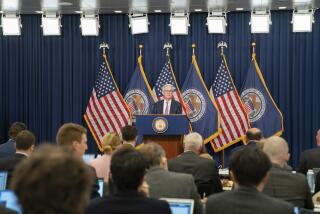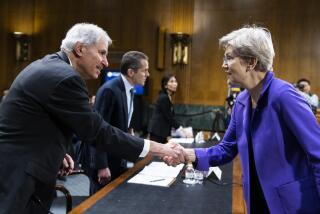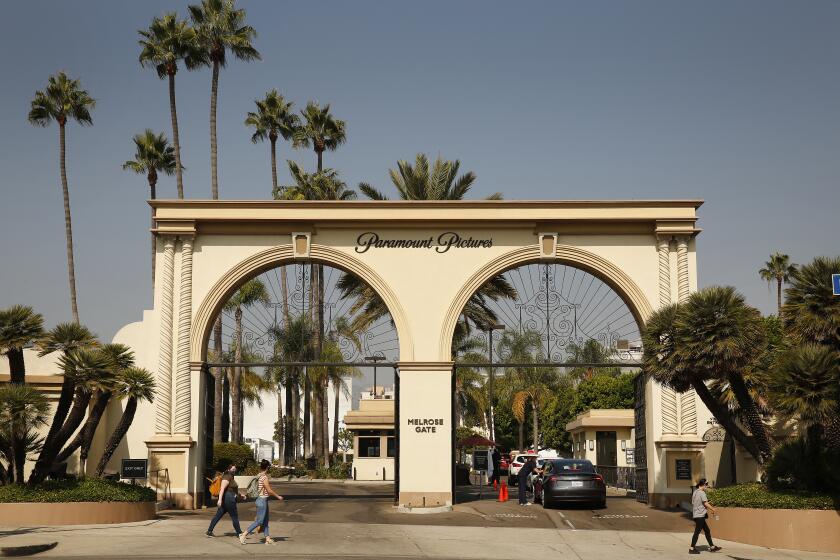Tough Stance Toward Airlines
- Share via
When Congress created an agency to facilitate loans to the shellshocked airlines after the terrorist attacks, critics decried the move as letting Uncle Sam not only select which carriers would survive but also re-engineer the structure of the U.S. air travel system.
At worst, opponents said the Air Transportation Stabilization Board could perpetuate the status quo in the industry, keeping the loss-plagued business on life support by doling out loan guarantees to industry giants that have high labor-cost agreements and inefficient operating systems.
But the Air Transportation Stabilization Board has surprised critics by mostly forcing the airlines themselves to dramatically reshape how they do business. The panel is being extremely cautious in providing government-backed aid to those airlines that have requested it, leaving the carriers to fly right on their own or risk collapse.
The ATSB, “whether they like it or not, is certainly shaping the way the industry evolves,” said Tom Hansson, who heads the U.S. airline practice for consulting firm Booz Allen Hamilton.
The changes might eventually strengthen the airlines, although at the cost of making air travel more expensive and less convenient for passengers. There could be fewer flights, longer waits at airports, modestly higher fares, fewer first-class seats and more restrictions on frequent-flier miles, some analysts said.
“In the short run it’s going to be painful for U.S. travelers,” said Meg VanDeWeghe, a former managing director at J.P. Morgan Chase and now an executive-in-residence at the University of Maryland’s business school. “But in the long run we’ll see a stronger industry. They’re going to be forced to focus on profitability and efficiency.”
The biggest issue now before the ATSB is UAL Corp.’s United Airlines, one of only three major airlines that sought a loan guarantee before the deadline June 28. But the board refused to rush a requested $1.8-billion guarantee to United because the airline hasn’t made the kind of deep cost cuts that the board demands.
As a result, United last week announced that it was teetering toward Bankruptcy Court unless it gets the employee wage cuts and other concessions it needs within 30 days.
United’s announcement last week was just one event in the most tumultuous week for the airlines since the terrorist attacks, with US Airways filing for bankruptcy protection and industry leader American Airlines, a unit of AMR Corp., unveiling a massive cutback in flight schedules and employees.
Continental Airlines joined the parade Tuesday, saying it would ground jets, sharply reduce its available seats and charge low-fare customers for certain services to slash $350 million a year from its operating costs. The Houston-based carrier said it hoped to avoid layoffs through a hiring freeze and attrition.
Continental’s brash chairman, Gordon Bethune, noted the problems at United, American and US Airways and said in a statement that his airline needs “some aggressive belt-tightening so we don’t end up like them.”
The airlines are grappling with a travel slump that has persisted much longer than industry executives expected, which is keeping a lid on fares--and the airlines’ incomes--while airline operating costs remain stubbornly high. The result has been massive financial losses among the major carriers--$7 billion last year and $3 billion to $5 billion this year.
But as it has from the outset, the ATSB is taking a hard line toward those carriers asking for loan guarantees, demanding they first provide a business model that assures repayment of the loans without putting U.S. taxpayers at risk.
The loan-guarantee program was part of a hastily approved $15-billion airline-bailout package approved by Congress after Sept. 11. The first $5 billion was sent directly to individual airlines as cash grants to help them recover from the two-day shutdown of civilian air travel after the attacks and the severe drop in passenger traffic.
The rest is in loan guarantees, so that the airlines can tap the capital markets for financing, with lenders and investors knowing the U.S. government stands behind the loans in case of default. The ATSB was created to judge applications for guarantees and was given wide discretion for setting the criteria.
The ATSB granted only one guarantee, to America West, a unit of America West Holdings Corp., and only after the Phoenix-based airline made steep concessions that included giving Uncle Sam the right to buy a 33% stake in the airline. Several other requests from smaller carriers--including Vanguard Airlines, National Airlines and Spirit Airlines--were denied.
The ATSB’s rigid stance comes despite strong political clout behind the airlines seeking help. More than 100 members of Congress signed a petition supporting United’s initial application. But the three voting members of the ATSB board include two appointees of the Bush administration, which objected to the loan-guarantee idea in the first place on grounds it would mean too much government interference in the airline business.
The three members are:
* Peter R. Fisher, Treasury undersecretary for domestic finance.
* Edward M. Gramlich, 63, one of the seven governors of the Federal Reserve Board.
* Kirk Van Tine, 53, general counsel of the Transportation Department.
Fisher and Gramlich are the designees of Treasury Secretary Paul H. O’Neill and Federal Reserve Chairman Alan Greenspan, respectively, both of whom voiced reservations about the loan program when it was being debated nearly a year ago. The Bush administration pointedly left out the guarantees from its initial proposal to help the airlines, but Congress prevailed and had them included.
The board is “putting pressure on these airlines to clean up their act, by dangling this carrot out there in the form of loan guarantees,” said Howard Seife, head of the bankruptcy practice at law firm Chadbourne & Parke in New York. “But they’re using that carrot very judiciously. They have enormous power and influence, there’s no doubt about it.”
Which is just what some industry observers want. With nearly everyone agreeing that the airline business needs to be restructured, some are calling on the ATSB to stay out of it, and let the industry and the Bankruptcy Court sort out the mess. “I don’t see a problem with” the ATSB rejecting United’s bid, said VanDeWeghe of the University of Maryland. “If they deny the help, they’re allowing market forces to cause United to do what it should be doing,” which is restructuring on its own, she said.
Many of United’s competitors, such as Continental, also oppose the ATSB’s involvement because they worry that the government’s help will give United an unfair advantage.
The ATSB would say only that it “looks forward to reviewing United Airlines’ revised application, which it will carefully evaluate based on the statute and the governing regulations” under the bailout program.
US Airways filed for bankruptcy reorganization last week while its own request for a $900-million loan guarantee is pending. But US Airways already has concessions from most of its employee groups, and the ATSB has indicated it will grant the carrier’s loan guarantee.
Treasury Secretary O’Neill said United is one of several airlines with unsustainably high labor costs, a problem the carriers would have to work out for themselves.
“Many of the airlines have compensation levels that they can’t support with the revenues they’re generating. Only they can deal with that issue,” O’Neill said last week. “That’s a problem at United, which they know.”
And he reiterated that the ATSB was not created to make hand-outs.
“The law gave us parameters for how to decide about who should get a loan guarantee,” O’Neill said. “It didn’t say, ‘Give everybody who comes down the chute a guarantee.’ ”
*
(BEGIN TEXT OF INFOBOX)
*
Air Transportation Stabilization Board
*
Edward M. Gramlich
A governor of the Federal Reserve System since November 1997
Board position: Chairman
Age: 63
Education: BA from Williams College, 1961; MA in economics from Yale, 1962; PhD in economics, Yale, 1965
Career highlights: Economics and public policy professor at the University of Michigan. Former chair of the university’s economics department and former dean of the School of Public Policy. Former acting director of the Congressional Budget Office.
*
Kirk Van Tine
General counsel, Transportation Department, since September
Board position: Voting member
Age: 53
Education: BS from U.S. Naval Academy, 1970; JD, University of Virginia School of Law, 1978
Career highlights: Former partner with law firm Baker Botts. Oversaw the firm’s litigation group in Washington.
*
Peter R. Fisher
Undersecretary for domestic finance, Treasury Department, since August 2001
Board position: Voting member
Age: 47
Education: BA from Harvard College, 1980; JD from Harvard Law School, 1985
Career highlights: Former executive vice president of the Federal Reserve Bank of New York.
*
David M. Walker
U.S. comptroller general, General Accounting Office, since November 1998
Board position: Nonvoting member
Age: 50
Education: BS from Jacksonville University, 1973; senior management in government certificate, Harvard University, 1986
Career highlights: Former global managing director for human capital services, Arthur Andersen, Atlanta. Assistant secretary for pension and welfare benefit programs, Labor Department. Former acting executive director of Pension Benefit Guaranty Corp.
*
Source: Times research
*
Times staff writer Warren Vieth contributed to this report.
More to Read
Inside the business of entertainment
The Wide Shot brings you news, analysis and insights on everything from streaming wars to production — and what it all means for the future.
You may occasionally receive promotional content from the Los Angeles Times.









